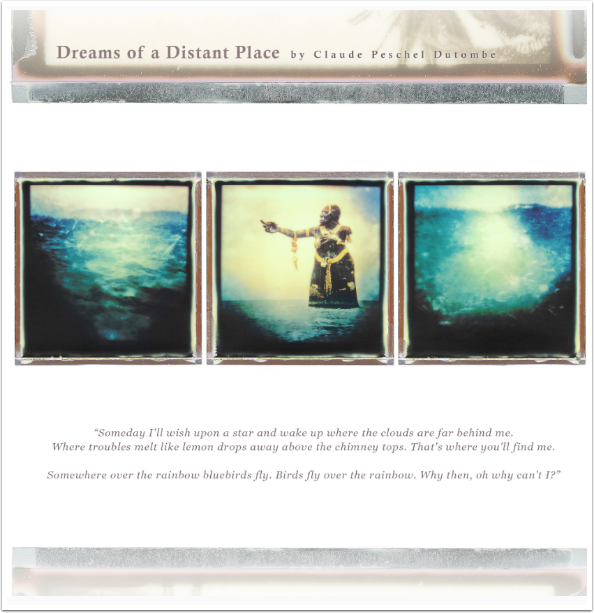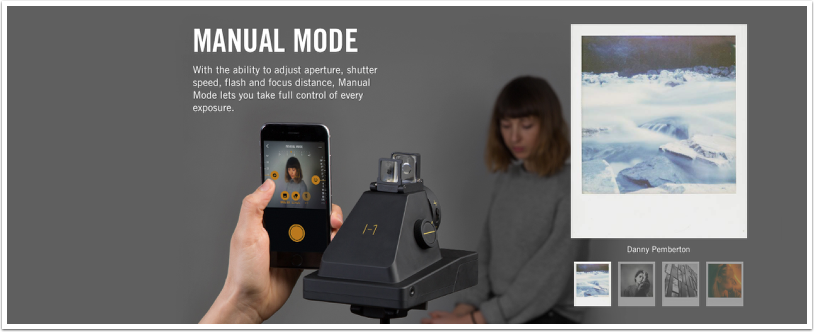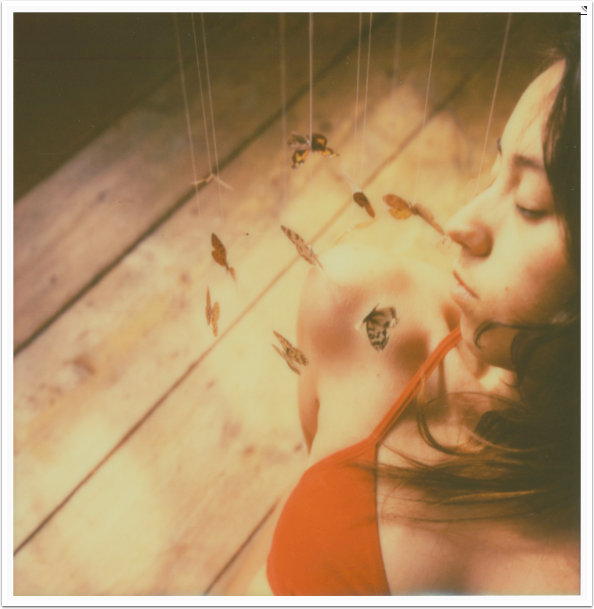‘Impossible’ Interview with Ale Di Gangi
We’re delighted to be working closer with The Impossible Project team as we continue to branch out and expand our reach with all things related to mobile photography. Analog post-processing of mobile images is becoming more and more popular and we’re going to make sure our readers are fully briefed on this very exciting development.
The Impossible Project is in many ways leading the way, but there is also a growing community of mobile artists and photographers experimenting with other analog post processing techniques in an attempt to make their mobile images stand out even more, in galleries, magazines and the like and we have viewed some outstanding images and techniques.
A good deal of my formal photographic training (many years ago) was spent in a huge college darkroom and it is an area that I’ve always enjoyed, I think you will too. I also had a very close working relationship with Polaroid built up through my years as Technical Editor for various UK photography print magazines/titles.
Today we are publishing the ninth of a series of ‘Impossible’ articles, this time with someone that many of us are familiar with already – Ale Di Gangi. Di Gangi is Italian, in his late forties and lives in Florence, Italy, with his partner. An accomplished amateur photographer, he works for “the biggest Internet company in Italy.”
Ale Di Gangi


‘Ruination & Sanctification’ – Ale Di Gangi
How long have you been shooting Polaroid/Impossible film?
First, let me say that my father has been taking photos his whole life; he takes photography seriously. Leica was his motto when I was a child and he banned Polaroid cameras from the house on the principle that they were crap – firmly believing that non-reprintable photography was useless and unworthy. After a whole life spent wanting to shoot Polaroids, I decided to react against this nonsense and finally treated myself to a 600 at the end of 2004. Only shortly after that, I found out that Polaroid would soon start retiring their film types one by one. Sometimes I hate my twisted sense of timing!
What cameras do you use?
I own about a dozen original cameras of various ages, formats and types, but what I mainly use now are an SX-70 and an SRL 680 – so I won’t miss out on any of the latest Impossible films. What I love about these cameras is that they feel so solid and reliable and yet so delicate at the same time, the best of retromodern! The fact that they are technically and optically superior to the rest of the range, and that the results are of a higher quality, are of course the main advantage. Also, when I take the camera out of my bag someone invariably goes “Aaaahhh” with stupor and admiration, and a small shiver of happiness runs down my spine!
Where do you shoot most often?
I tend to shoot mostly outside, since I much prefer natural daylight. As for the films, I like to test them all out, but now it’s mainly Color 600 and SX-70. I absolutely love the new coloured frames.
How would you describe your work?
I like to think that my photos can both stand alone or be viewed as part of a series. Nonetheless, I do believe that to properly judge what I do (hate it or appreciate it) it is nicer to have a broader look at the whole story. Is that a pretentious thing to ask? Maybe yes, but the series is a matter of facets and different styles, mostly due to my desire to always keep evolving and changing as a photographer. My primary intent with instant photography is to reconvey the warmth and nostalgia of the analog era; there is nothing that can compare with the colours of that period. There is softness and an overall sense of magic in these framed shots, with the impression of suspension in time. This can be transmitted at first sight, sometimes even separately from the subject and the quality of the shot itself. Generally, I am inspired by whatever surrounds me, everything can turn into an input. To put it in a simpler way, I “recognize” a photograph opportunity when I see it – and it can come from anywhere. On the other hand, trying to deliberately look for inspiration is usually the worst thing to do. Taking photos on request is quite a risk for me, since I might completely blow it and end up feeling miserable. Inspiration flows to me naturally – and sometimes it disappears for a while too! But the best part of this peculiarity is that I get lots of inspiration, coming at all times from all sources; people, films, books, music, places, details. Anything you can think of might trigger it!

‘Early morning on Solaris’ – Ale Di Gangi
Tell us a little about the four works you have chosen as your favourites?
Ruination & Sanctification: this early PX600 First Flush shot shows the effects of the poor pod problem, before I knew it was happening and was able to take action to stop it. I have chosen this photo because it is one of a few that faded to nothing, my heart cries every time I look at it because it’s a reminder of everything that vanishes in life. It is the portrait (originally titled “Remember 1975”) of a dear friend who now lives far away, holding another framed portrait of hers (“1975”) on display at my possible exhibition (read further below about it), and it builds like a game of references. For the whole story, you may want to go to Flickr and read the descriptions there
Early morning on Solaris: this is a typical example of my eclecticism in finding inspiration. Early one morning last summer I was staring at the sea and I had this memory of the Andrej Tarkovskij film flashing in my mind and the photo came out just the way I had imagined it. The woman in the photo did not notice me at all, she was all absorbed in her thoughts and this adds to my fascination for the final result.
Please Tell Them I Am So Sorry: this was a joke inspired by the Blair Witch Project film, I still laugh when I see it. The friend portrayed hates it, but I consider this as one of my most successful “creative” portraiture efforts. You can hate it, too, still here you can find one of the most ironic, I’d say sardonic, sides of my mind. This photo speaks of me in many senses, trying to not take life too seriously. Are you laughing now?
The last one still doesn’t have a final proper title, so let’s call it Trees in Wintertime. I chose it because it is deeply linked to memories of a nice moment in my life that occurred on last Christmas. There is a real sense of peace here, I shot it while with my family and with a sense of acceptance I finally felt being with them and my partner together in my parents’ living room. The trees outside of their window stand in a magical and very cold winter sunset, freezing the incomparable beauty of the Tuscan sky. The peculiarity of the colours here is wildly strange, since they only became properly visible only a couple of days after the shot was taken, until then I believed the film had been wrongly packaged as 600 Color but was really B&W.

‘Please Tell Them I Am So Sorry’ – Ale Di Gangi
Do you have any helpful creative techniques or advice you would like to share?
Have you ever tried printing a hi-resolution scan of a Polaroid or Impossible shot, including its frame, in a large format? The effect you get, not only from the details of the photo, but from the very texture of the paper frame is one of the most exciting experiences I have ever had from taking (and exhibiting) photographs.
Do you have any upcoming exhibitions/publications?
I do have an exhibition opening in my town on the 8th of March; though this one, titled VeroSimile”(a pun between “real” and “plausible,” “probable” and “likely”) is not made of instant photography but of painterly iPhoneography. I have been planning a book of my instant photographs for a while now – the only problem is I am not able to pause shooting and the collection of photos to include is ever changing and growing. This has until now prevented me from finalising a proper book. But it’s going to happen, definitely, soon.
The last instant exhibition I have been part of was a collective held here in Firenze in March 2013, called “It’s raining Polaroids”. I had 5 shots hanging from a ceiling in an old building and the whole installation was rather poetic and peculiar. Also, I still am very proud of my 2010 instant exhibition, and would like to re-edit it sometime and bring it to other interested venues. It’s called ‘The possible exhibition’ (yes, there is a pun intended in the name) and includes both original Polaroid/Impossible photos accompanied by a few plexiglass reproductions on 1:1 and large-scale panels: details, photos and videos about this exhibition can be found on my website.

‘Trees in Wintertime’ – Ale Di Gangi
Who are your favourite photographers, living or dead?
Oh my! That is a tricky question for me, because I can hardly remember names and the list could be very long. So, I’ll name one and only one: Andy Warhol. …And David Sylvian, too. OK, that makes two of them, but hey!
What are you hoping for from Impossible during the next year?
A new camera please! I can’t wait to see what Impossible can come up with. Also, being able to toy around with new experimental and unfinished films is always such a joy – hopefully Impossible will keep releasing more weird and beautiful stuff for it’s Pioneers (how about a reissue of the Fade to Black film? I was crazy about it.)


